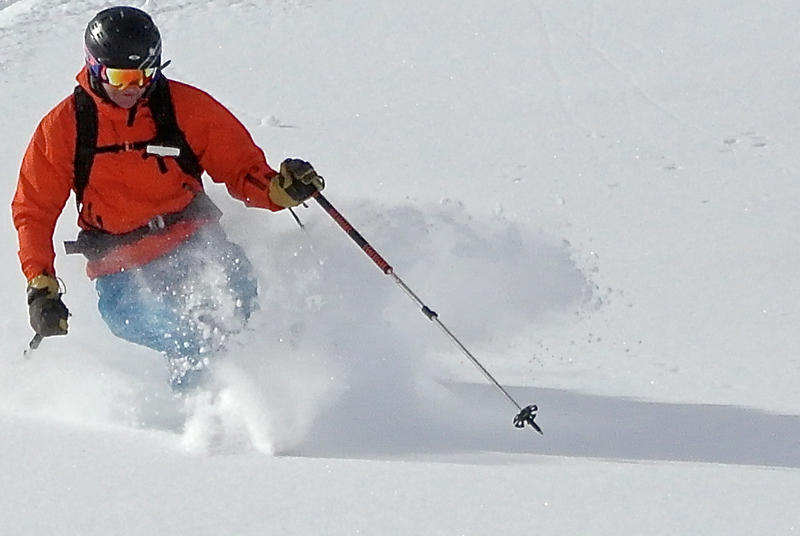Avalanche Airbag Systems – A Quick Overview

Many different statistics have been quoted about success rates of avalanche airbag systems in preventing fatalities. It all depends on how the data is collected and how it is filtered. However, even the most cynical experts seem to agree that, along with the avalanche transceiver, they are the best piece of technology around (best way to help you survive an avalanche).
Our only reservation about people wearing avalanche airbags is that these pieces of equipment should never be seen as a substitute for prevention (good training and continual knowledge-based decision making throughout the day). They can save lives by keeping you from being fully buried in an avalanche, if you deploy them correctly and are in ‘survivable’ terrain. By ‘survivable’ terrain we mean areas where there are no obstacles in your path (airbags are not much use if you are taken over cliffs and into trees). What airbags are great for is that they keep you on the surface of a moving avalanche, so that you can be located and rescued more quickly. (The time taken locating an avalanche victim is crucial in their chance of survival).
All the different systems work on the same principle. Very basically: Your avalanche backpack incorporates 1 or 2 airbags and a pressurised air cannister. If caught in an avalanche, you pull a handle on your backpack to trigger the release of compressed gas into the airbag/s. These inflated airbag/s increase your volume. The scientific principle of ‘inverse segregation’, whereby larger objects will always move to the top when in motion, enables you to rise to the surface of a moving avalanche. Dale Atkins, President of the American Avalanche Association, describes this as the ‘brazil nut effect‘: If you put a load of mixed nuts in a can and shake it, the brazil nuts (the biggest ones) will come to the surface. The manufacturers’ websites below (highlighted in orange) contain the more technical details.
Brief overview of the 3 main systems available in Europe:
ABS (the original system, around and developed since 1985)
- Twin airbag system, with a total capacity of 170 litre (2 x 85 litre balloons).
- Inflates at the sides from the shoulder straps, bit like giant butterfly wings.
- Nitrogen gas.
Manufacturers’ top selling points:
- Double safety. In case one airbag doesn’t deploy or gets damaged in the avalanche, the other one is also there.
- The 2 inflated orange airbags are very visible to your companions making it easier for them to find you, if you are taken by an avalanche.
- Unobstructed view and freedom of movement if caught, not interfering with your sense of direction.
Snowpulse (2nd company to enter the market)
- Single airbag system. 1 airbag, capacity 150 litre.
- Inflates from shoulder straps and top of the bag, behind the head and neck.
- Compressed air.
Manufacturers’ top selling points:
- ‘Head on top’ technology. Designed to keep you on your back with your head out of the snow to avoid asphyxiation.
- Airbag helps to protect your head, back of neck and chest from trauma during an avalanche.
- Ergonomic, lightweight design.
BCA (has now gained approval for sale in Europe)
- Single airbag system. 1 airbag, capacity 150 litre.
- Inflates from top of backpack, behind the head and shoulders.
- Compressed air.
Manufacturers’ top selling points:
- Protects the head and neck and upper body from trauma.
- Clear peripheral vision to see an escape route if caught in an avalanche situation, due to positioning of airbag behind head but away from hips and arms.
- Lighter and less expensive than other makes.
In Conclusion…
The international avalanche community has strongly endorsed avalanche airbags as the best way of surviving a moving avalanche (i.e. you will not float up to the top of avalanche debris if you are buried – or still buried – after the avalanche has come to rest. For example if the avalanche has taken you into a hole and you end up buried under several metres of snow, you will not float up OR if you forget to inflate the airbags until you are buried and the avalanche has stopped, you will not float up through the static compact snow). The 3 different types of airbag system outlined above are all good quality products.
To choose which one’s best for you, consider things like how well they fit, which volume is most suitable for your needs, weight, price, and convenience of getting the cannister serviced. Off-piste suppliers’ websites, such as Snowshepherd in the UK, often contain great information to help you. A particular favourite of ours is the new Ortovox ABS range, with a womens’ version out this year, see our previous blog.
Perhaps you could look at buying an avalanche airbag system as being both the best and the worst investment you will ever make as an off-piste skier/boarder: best because, in the worst case scenario, deploying one could save your life; worst because, hopefully, you will never be caught in a situation where you need to use it at all.
Stay tuned for our future articles, including possible problems you may encounter when trying to transport your airbag by plane, and solutions to get around this.





0 Comments